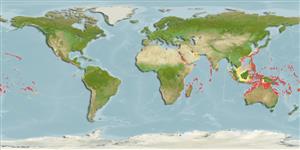Actinopterygii (ray-finned fishes) >
Perciformes (Perch-likes) >
Labridae (Wrasses) > Bodianinae
Etymology: Bodianus: Bodianus after Bodiano or Pudiano, from the Portuguese pudor, meaning modesty (Jordan & Evermann, 1896).; anthioides: Name from the Greek masculine noun 'anthias', a common name for members of the anthiine serranid fishes, and 'oides' for having the form of, refers to the similarity of this species to various anthiine species (Ref. 75973).
Environment / Climate / Range
Ecology
Marine; reef-associated; depth range 6 - 60 m (Ref. 1602), usually 6 - 60 m (Ref. 27115). Tropical; 23°C - 27°C (Ref. 27115), preferred ?; 32°N - 28°S
Indo-Pacific: Red Sea to South Africa (Ref. 35918) and east to the Line and Tuamoto islands, north to southern Japan, south to New Caledonia and the Austral Islands.
Size / Weight / Age
Maturity: Lm ? range ? - ? cm
Max length : 24.0 cm SL male/unsexed; (Ref. 1602)
Adults inhabit seaward reefs. They occur on reefs rich with invertebrates such as gorgonians, seawhips and black corals (Ref. 48636). Common along steep outer reef slopes deeper than 25 m in Micronesia. Usually seen as lone individuals (Ref. 48636). Juveniles pose as cleaners (Ref. 8631). May be solitary or may exist in pairs (Ref. 5503). Oviparous, distinct pairing during breeding (Ref. 205).
Life cycle and mating behavior
Maturity | Reproduction | Spawning | Eggs | Fecundity | Larvae
Oviparous, distinct pairing during breeding (Ref. 205).
Gomon, M.F., 2006. A revision of the labrid fish genus Bodianus with descriptions of eight new species. Rec. Aust. Mus. Suppl. 30:1-133. (Ref. 75973)
IUCN Red List Status (Ref. 115185)
CITES (Ref. 94142)
Not Evaluated
Threat to humans
Harmless
Human uses
Aquarium: commercial
More information
ReferencesAquacultureAquaculture profileStrainsGeneticsAllele frequenciesHeritabilityDiseasesProcessingMass conversion
Tools
Special reports
Download XML
Internet sources
